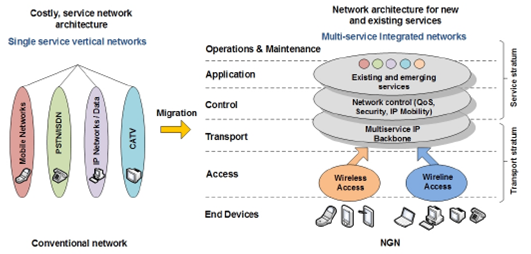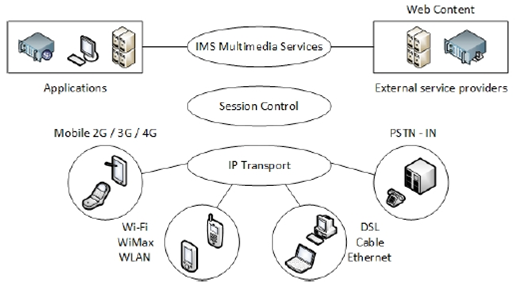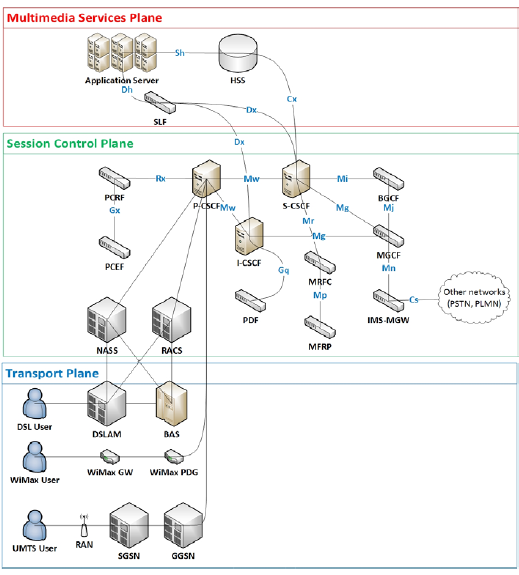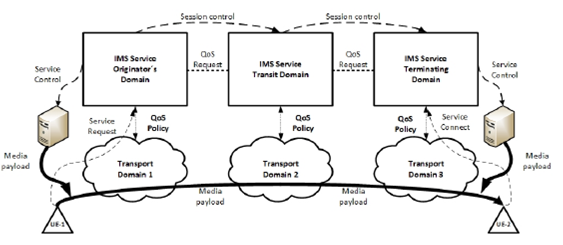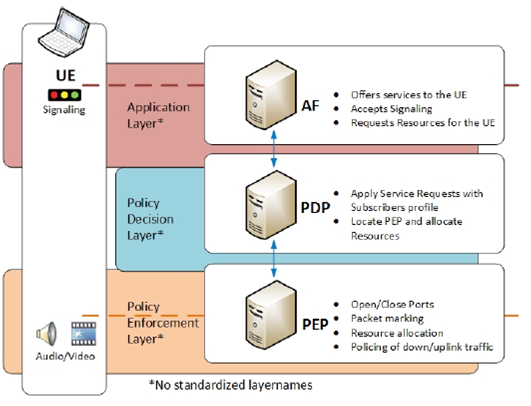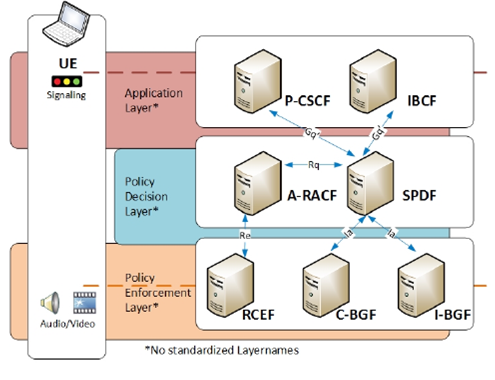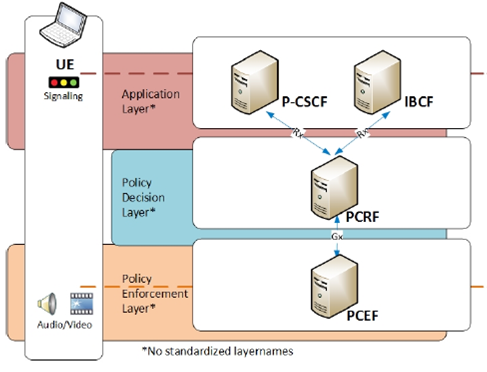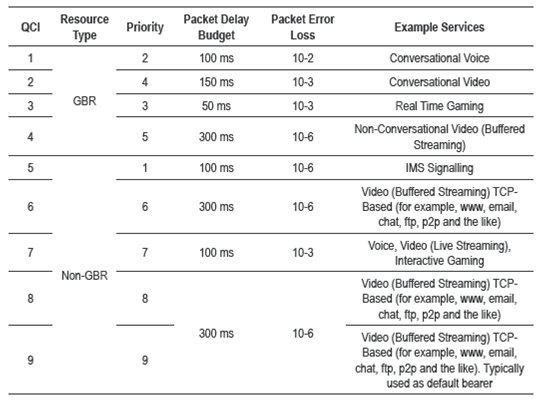INTRODUCTION
The concept of next-generation networks (ngns) was introduced to face the reality of the telecommunications industry, characterized by open competi tion among operators due to the deregulation of markets, the convergence between networks and services, and the increasing demand for multimedia applications 1. This reality creates challenges for operators both in their infrastructure and in their portfolio of services; operators must quickly adopt new technologies and the ability to develop services in a short time, at low cost, to meet market needs 2.
Growing mobility needs and customizing services provided to consumers have given rise to more efficient ways to provide services using any tech nology available at any given time; therefore, network infrastructures must provide sufficient resources to offer value-added services. ngns provide a model that allows the operator to improve the provision of resources to integrate all types of telecommunications services under a single network infrastructure adopting internet protocol (ip); this model is referred to as All-ip 2. Therefore, operators can move from a model of vertical archi tecture, in which each service they provide has a separate infrastructure (mobile phones, switched telephony, data networks, television networks, etc.) with corresponding types of access, transport, control and application infrastructure, to an independent landscape architecture in which these services are integrated (figure 1).
The telecommunications industry is adopting the IP Multimedia Subsystem (ims) as the reference architecture for the development of all telecommunica tions services for ngns 4 that are able to support current telecommunica tions services and that will be useful in the future. One advantage of ims is that it integrates the concept of the convergence of services supported by heterogeneous networks, i.e., networks of different types such as fixed, mobile or the internet. However, ims does not standardize applications but facilitates access to multimedia applications and voice access to different types of terminals and access technologies.
One of the most important aspects concerning the convergence of services is Quality of Service (QoS) because IP networks originally lacked QoS control mechanisms. These networks were designed to provide service delivery without guaranteeing the reliability of the corresponding information, depending on the amount of bandwidth required, especially for services requiring real-time connections (5). Based on recommendation Y.2001 (6) of the International Telecommunication Union (itu), the necessary features were established to ensure end-to-end (e2e) QoS in ngns.
Globally, QoS is currently one of the most researched areas because of its interest to users, operators and regulators 7. ims is an IP-based architecture that is constantly evolving and is heterogeneous 8 in operator networks; it is characterized by a variety of protocols used in operator network infra structures. Therefore, QoS policy control has become an important research topic 9), (10.
IP MULTIMEDIA SUBSYSTEM
The IP Multimedia Subsystem is a reference architecture for next-generation service provision standardized by the 3rd Generation Partnership Project (3gpp) and introduced into umts Releases 5 and 6 (March 2003). ims allows telecom operators to offer multimedia services, such as voice, data, video and combinations thereof, under the same infrastructure through packet switching networks based on IP 11. ims is considered a subsystem because it is part of a complete network in which other components are required, such as an access network, to fully function as a service deployment system 12.
This subsystem is important because it allows different types of access networks to be integrated regardless of technology or internet services combining fixed and mobile networks 13; however, for the 3gpp ims described from the point of view of mobile operators (those that support new applications), a body of standardization telecommunication members of the European Standards Institute (etsi) called the Telecommunications and Internet Converged Services and Protocol for Advanced Networking (tispan) adds the necessary ims compatible with networks of fixed-operator (convergence) specifications. The flexibility of this architecture allows for modifications and extensions in the subsystem 14, and it also simplifies the application design by harmonizing the ability to obtain session control through the Session Initiation Protocol (sip) 15.
Figure 2 illustrates the ims architecture and its three main levels 16, which are as follows: the multimedia services layer; the control session layer; and the ip transport layer, in which an ims-based network architecture enables the convergence of different technologies for access networks, such as a fixed network pstn, a broadband xdsl, a wireless lan, or 2G, 3G and 4G cellular mobile networks.
A distinction must be made between "ims core" and "ims" because the ims architecture refers to a "core" or "ims core" (defined by 3gpp) in addition to a non-ims subsystem number (defined by tispan), such as the Network Attachment Subsystem (nass), a Resource Admission Control Subsystem (racs) or the pstn Emulation Subsystem (pes) 17. The central components of the ims architecture are the Call Session (or State) Control Function (cscf) entities, which are actually sip servers. These entities have specific functions for signaling and routing traffic 18 and are located at the core level of the Proxy-cscf (p-cscf), the Interrogating-cscf (i-cscf), the Serving-cscf (s-cscf), the Home Subscriber Server (hss) and the Application Server (as).
Figure 3 shows the different types of components used in the ims architecture 19; the main elements found in a basic solution are the CSCF entities. Simi larly, various functional entities for managing fixed and mobile networks are defined, and some entities are responsible for contacting the transport network to ensure QoS and prevent misuse of the services provided.
Different protocols are used by these components according to their signal ing function, such as session control through the Session Initiation Protocol (sip), authentication control via Diameter or policy control by the model Open Policy Service (cops); the components have been standardized by the Internet Engineering Task Force (ietf) for the purpose of adopting open protocols used in the tcp/ip architecture to create a flexible platform that can be scalable and compatible with legacy networks 20. The specification of the functional architecture of an ims subsystem can be found in 3gpp 23.228 21, where interfaces, protocols and applications that can be offered to users under the ims network are defined.
QUALITY MECHANISMS
One of the essential criteria for evaluating a system lies in the measurement of network performance from the points of view of deployment, operation and customer satisfaction. For quality assessment, there are two approaches, Quality of Experience (QoE) and Quality of Service (QoS) 22:
Quality of Experience is related to the satisfaction levels centered on the user according to their expectations, perceptions and un derlying effect on QoS 23. The overall effect of these factors has a subjective evaluation that can vary between low, medium or high percentages 24. These parameters are focused on the user and are of great research interest 25.
Quality of Service provides a set of metrics focused on network performance 26, which can be technically evaluated and are ne gotiated based on the possible factors that define QoE 22.
QUALITY OF SERVICE
According to ITU Recommendation E.800 27, Quality of Service (QoS) is defined as The totality of characteristics of a telecommunications service that bear on its ability to satisfy stated and implied needs of the user of the service. ims architecture focuses on ensuring that the applied QoS policies between specific requests for applications (Session Initiation Protocol - sip / Session Description Protocol - sdp) and multimedia flows (Real-time Transport Protocol - rtp) are defined by the network operators according to the type of business and service requirements at the application level that are used to manage the network resources and enhance QoS 28.
In IMS QoS, control plays an important role through a series of indicators that allow for evaluations according to service type, such as bandwidth, e2e delay (delay), delay variation (jitter), data rate and bit error rate 29). Within the context of an IP network, a service refers to the overall traffic handling of a client through a particular domain; a service is useful only if it meets the requirements of the end user 30. The organizations 3GPP and tispan (Telecoms & Internet Converged Services & Protocols for Advanced Networks) define a set of four classes of QoS for transport networks 19). Corresponding to the ims services, these requirements also apply to the interconnection of networks that are IP-based (ip-can) access networks and ims. These four classes are listed in table 1.
An e2e multimedia session can traverse a series of heterogeneous admin istrative domains in NGNs, in which the control system of policies must be able to guarantee the QoS resources in all domains involved (Figure 4). Each domain defines its own mechanisms and policies for the provision of QoS depending on the technologies that are accessible to the operator; however, in an e2e session, a mutual negotiation of Service Level Agreements (slas) between the domains involved is required. An sla is a formal contract 31 negotiated between two parties that defines the commitment levels associated with network performance and service responsiveness. The two parties can be a user and an operator or two operators, in which case one takes the role of customer to purchase services from another provider 32.
Protocols for handling QoS
To provide end-to-end IP QoS at the network level, ietf has defined the reserve model-based Integrated Services (IntServ) model for resources and traffic prioritization based on Differentiated Services (DiffServ) 33), (34. DiffServ is based on the division of traffic into different classes and the prioritization of these aggregates with a code in the datagram when congestion occurs 9. The nodes in the network must know and identify the code to prioritize packets 35.
IntServ implements a channel reservation and admission control packets through the nodes in the network using the rsvp (Resource Reservation Protocol); the implementation consists of three types of services, controlled, guaranteed and best effort load 36. However, there are issues concerning scalability and complexity, which are overcome by implementing DiffServ 37; all cases of interoperability between operators are based on the use of SLAs, which is an integral part of DiffServ 38.
Policy-based QoS Architectures
To provide QoS in NGNs, the IETF organizations ETSI TISPAN and 3GPP have defined different architectures for the control of data flows. The ietf describes a policy framework through RFC 2753 (39) (Figure 5), which sets policy rules defined as models that become network configurations or devices in an administrative domain. These rules are stored in repositories called Policy Decision Points (pdps) and Policy Decision Functions (pdfs); these repositories recover the rules of appropriate policies in response to requests for policies that are generated by the QoS requirements of services 40. The Policy Enforcement Point (pep) refers to the point where a server enforces policy admission control and policy decisions in response to a transaction request from a user who wants to access a resource on a server network.
The ETSI TISPAN architecture developed its own QoS assurance through the standard ETSI ES 282 003 42; the architecture is called the Resource and Admission Control Subsystem (racs, Figure 6), which is a subsystem respon sible for NGN control element policy, resource reservation and admission control. It is the main component that interacts with the access network and the core network that carries a service that can affect the priorities of the packets through the DiffServ protocol and book resources with RSVP 43.
racs is the logical element of the largest network that allows for interaction between the service layer, the transfer functions of the control resources and QoS support within the respective NGN 44.
3gpp is defined in ts 23.203 45 and specifies one policy-based QoS called PPC (Policy and Charging Control, figure 7) from the standpoint of the mobility architecture that was introduced in 3GPP R7 (46). The entity PCRF (Policy and Charging Rules Function) is responsible for policy and charg ing control; the Execution Policy and Charging Function (pcef) associates reference points to them 47. The concept and the QoS architecture used by the 3gpp specification are described in 3gpp ts 23.107 48. The concept of end-to-end QoS architecture used by the 3gpp specifications is described in 3gpp ts 23.207 49. The pcc architecture is flexible and applicable to a variety of services, access networks and load models; however, it is not well adapted to multimedia service requirements that are dynamically negotiable with QoS according to changing conditions in the network 50.
QUALITY OF SERVICE MANAGEMENT
To implement the various policies of quality of service management archi tectures described above, it is necessary to make a study of the parameters involved in ensuring the selected service according to 3gpp ts 23.107 48, 3gpp ts 23.203 and 3gpp ts 23.207 49.
Traffic Policing
This mechanism refers to the packets that are discarded by limits or oper ating policies, dropping packages that have the lowest priority while are being send. This mechanism is used in routers and is applied to ip packets on input and output interfaces 51, depending upon the following variables according to the rfc 2698 52:
pir (Peak Information Rate): maximum transmission rate of a client in bits/s and previously agreed between customer and operator with any type of contract or service level agreement (sla). The PIR can never be greater than the capacity of the line provided by the operator 53.
CIR (Committed Information Rate): average rate of long-term traffic that the operator undertakes to provide a customer with a contract or service level agreement (sla). This parameter is measured in bits/s and is generally less than pir. In any case, the cir can never be greater than the PIR 53.
CBS (Committed Burst Size): Maximum burst size allowed on the network. Specifies the maximum number of bytes that can be trans mitted to the PIR, while complying with the agreement of the CIR 53.
PBS (Peak Burst Size): similar to CBS but defined with respect to PIR instead of regarding the CIR parameter 53.
Traffic Shaping
Traffic shaping uses a policy based on queueing and subsequent extrac tion of packets to maintain the rate of the traffic. Unlike traffic policing, the original characteristics and traffic delays disappear due to the eueue 53. It is widely used by service providers and users to always guarantee the contracted bandwidth 51.
Quality of Service Attributes related to Policy Desition Point
The Release 99 of 3gpp recommendations defines QoS attributes such as Traffic class (Table 1), Delivery order, SDU format information, SDU error ratio, Maximum SDU size, Maximum bit rate for uplink, Maximum bit rate for downlink, Residual bit error ratio, Transfer delay, Traffic-handling priority, Allocation/retention priority, and Guaranteed bit rate for uplink and Guaranteed bit rate for downlink 52.
QoS parameters related to policy control
The following mechanisms (figure 8) are managed by the pcrf 54 to ensure the traffic over the lte (Long Term Evolution) and lte-Advanced networks 55:
• QoS Class Identifier (qci) is a scalar valor that control packet for warding treatment (for example, scheduling weights, admission thresholds, queue management thresholds, link layer protocol configuration and so on) 52.
Allocation and Retention Priority (arp) It is used as an indicator of priority setting processes or modification of an EPS bearer service enabling the network to decide whether to accept these processes depending on available resources 55.
MBR (Maximum Bit Rate) indicates the maximum number of bits delivered to the network or by the network within a period of time 52.
Guaranteed Bit Rate (gbr) indicates the guaranteed number of bits delivered to the network or by the network within a period of time 52.
DISCUSSION
The central problem is to provide consistent end-to-end QoS to an IP ser vice in such a way that the requested QoS requirements are met when the deployment of a service infrastructure involving two or more operators, being autonomous networks whose administrative domains, are managed according to their own policies.
Although operators must agree on QoS requirements for a particular service among a set of IP services, operators do not configure their networks in the same way. On the other hand, operators and service providers have their own internal topologies and QoS mechanisms that depend on their devices and other management requirements that are non-technical, and it is ob served that the ims has become the defacto standard in the deployment of lte networks, due to its open interfaces for deploying converged services. Further studies should consider this reality taking as baseline the Policy and Charging Control framework defined by 3GPP. That is why it is necessary to develop a guideline that allows operators to maintain a consistent level of QoS interconnections without depending on the complexity of the network.
Similarly, the regulatory aspects regarding the quality of service must be taken into consideration by the regulator. In the case of Colombia, the CRC has been working on issues relating to the adoption of next-generation net works by the industry group (56), which aims to promote1 "...cooperation among all industry players involved in the development and deployment of ngn as well as to track the evolution of the same..." in order to guarantee sla compliance for the user and address the implications of the adoption of these technologies in terms of the convergence of services and markets.
CONCLUSIONS
The evolution of operator infrastructure has led to the implementation of softswitches that allow migration to an All-IP network. However, the IMS architecture has been dominating industry due to its open interfaces for the deployment of converged services. The main challenge is to provide a consistent end-to-end Quality of Service through an IP service, such that the requested QoS requirements are satisfied when the deployment of a service involves the infrastructure of two or more operators, which are autonomous networks whose administrative domains are managed according to their own policies. Although operators must agree on the QoS requirements for a particular service among a set of IP services, operators do not configure their network devices in the same way because they have their own internal topology and QoS mechanisms that depend on their network devices and other non-technical management requirements.













